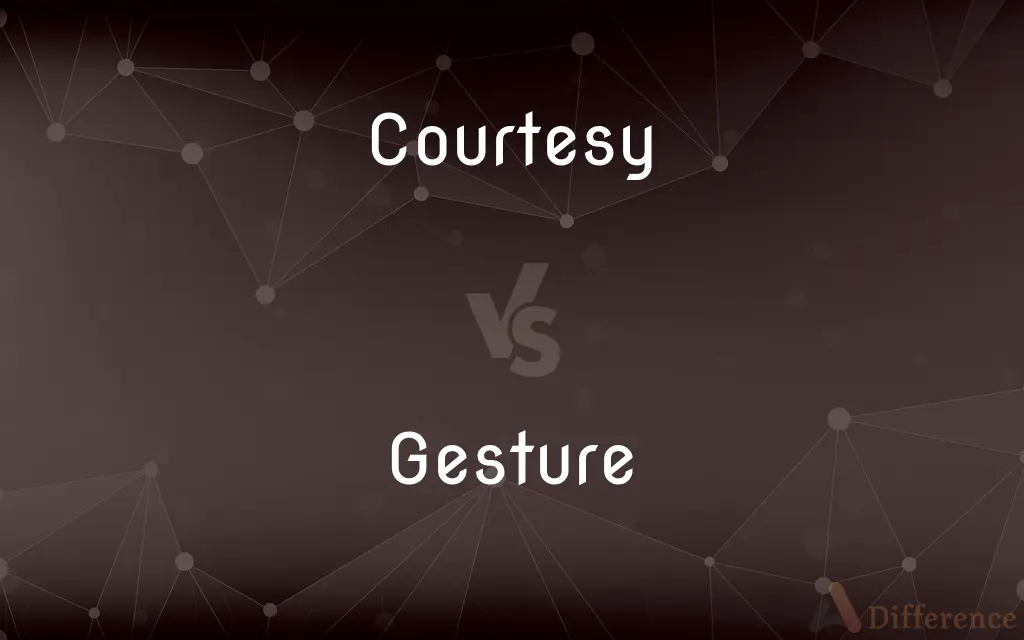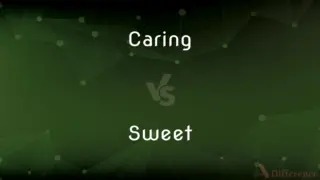Courtesy vs. Gesture — What's the Difference?
By Urooj Arif & Fiza Rafique — Updated on May 13, 2024
Courtesy refers to politeness and good manners in behavior, while a gesture is a physical or verbal act expressing a thought or feeling.

Difference Between Courtesy and Gesture
Table of Contents
ADVERTISEMENT
Key Differences
Courtesy encompasses general politeness and respectful behavior typically governed by social norms and etiquette, emphasizing respect in interactions. On the other hand, gestures are specific actions or movements, often non-verbal, used to convey messages or emotions, like a wave or a nod.
Courtesy often manifests in verbal interactions or through considerate actions, aimed at maintaining social harmony. Whereas gestures can be either intentional or spontaneous and are powerful tools for nonverbal communication, transcending spoken language.
In many cultures, courtesy is expected in almost all social situations and can include verbal expressions like saying "please" and "thank you." Conversely, gestures might not be universally understood, as their meanings can vary significantly across different cultures.
The practice of courtesy can significantly influence the tone of a conversation or interaction, promoting a positive atmosphere. On the other hand, gestures, while impactful, can sometimes lead to misunderstandings if misinterpreted or used inappropriately in a cultural context.
Courtesies are often taught explicitly through societal norms or etiquette classes, highlighting their importance in daily social interactions. Gestures, however, are usually learned implicitly through observation and can be instinctive or culturally specific.
ADVERTISEMENT
Comparison Chart
Definition
Politeness in behavior and interaction.
Physical or verbal act expressing thoughts or feelings.
Purpose
To show respect and maintain social harmony.
To communicate specific messages or emotions non-verbally.
Learning Method
Often taught through societal norms and etiquette.
Typically learned through observation and cultural context.
Cultural Variation
Generally consistent within cultures, varies more broadly between them.
Highly variable, with specific gestures having different meanings across cultures.
Example
Saying "thank you" when receiving a gift.
Nodding to indicate agreement or acknowledgment.
Compare with Definitions
Courtesy
Respectful behavior towards others.
She displayed courtesy by holding the door open for the elderly man.
Gesture
An intentional display of emotion through movement.
The gesture of raising his glass was an invitation to toast.
Courtesy
The act of being considerate to others.
Offering her seat to a pregnant woman was an act of courtesy.
Gesture
A non-verbal communication form using body movements.
She waved goodbye, a friendly gesture.
Courtesy
Manners dictated by cultural norms.
His knowledge of dining etiquette showcased his courtesy.
Gesture
Verbal expressions accompanying physical actions.
Pointing to the door while saying Exit is a clarifying gesture.
Courtesy
Courtesy (from the word courteis, from the 12th century) is gentle politeness and courtly manners. In the Middle Ages in Europe, the behaviour expected of the nobility was compiled in courtesy books.
Gesture
A gesture is a form of non-verbal communication or non-vocal communication in which visible bodily actions communicate particular messages, either in place of, or in conjunction with, speech. Gestures include movement of the hands, face, or other parts of the body.
Courtesy
The showing of politeness in one's attitude and behaviour towards others
He treated the players with courtesy and good humour
Gesture
A movement of part of the body, especially a hand or the head, to express an idea or meaning
So much is conveyed by gesture
Alex made a gesture of apology
Courtesy
A curtsy.
Gesture
Make a gesture
She gestured meaningfully with the pistol
Courtesy
Polite behavior.
Gesture
A motion of the limbs or body made to express or help express thought or to emphasize speech.
Courtesy
A polite gesture or remark.
Gesture
The action of making such a motion or motions
Communicated solely by gesture.
Courtesy
Consent or agreement in spite of fact; indulgence
They call this pond a lake by courtesy only.
Gesture
An act or a remark made as a formality or as a sign of intention or attitude
Sent flowers as a gesture of sympathy.
Courtesy
Willingness or generosity in providing something needed
Free advertising through the courtesy of the local newspaper.
Gesture
To make gestures.
Courtesy
Given or done as a polite gesture
Paid a courtesy visit to the new neighbors.
Gesture
To show, express, or direct by gestures
Gestured her disapproval.
Courtesy
Free of charge
Courtesy tickets for the reporters.
Gesture
A motion of the limbs or body, especially one made to emphasize speech.
The middle-finger gesture is really a nonverbal swear.
This Web browser can be controlled with mouse gestures.
Courtesy
(uncountable) Polite behavior.
Please extend them the courtesy of your presence.
He was always known for his grace, kindness, and courtesy to people of every rank.
Gesture
An act or a remark that serves as a formality or as a sign of attitude.
We took flowers as a gesture of sympathy.
Courtesy
(countable) A polite gesture or remark, especially as opposed to an obligation or standard practice.
I offered them a ride simply as a courtesy.
Gesture
(GUI) A motion made with a pointing device, or on a touchscreen, that is recognised by the system as a command.
Courtesy
(uncountable) Consent or agreement in spite of fact; indulgence.
They call this pond a lake by courtesy only.
Gesture
(obsolete) The manner of carrying the body; position of the body or limbs; posture.
Courtesy
(uncountable) Willingness or generosity in providing something needed.
They received free advertising through the courtesy of the local newspaper.
[on a label, caption, etc.] Courtesy the Smith Foundation: [e.g.] use of this image was allowed through the courtesy of the Smith Foundation.
Gesture
(intransitive) To make a gesture or gestures.
My dad told me never to gesture with my hands when I talk.
Never gesture at someone using your middle finger: it may be perceived as an insult.
Courtesy
A curtsey.
Gesture
(transitive) To express something by a gesture or gestures.
He gestured his disgust.
Courtesy
(law) The life interest that the surviving husband has in the real or heritable estate of his wife.
Gesture
(transitive) To accompany or illustrate with gesture or action.
Courtesy
Alternative form of curtsey
Gesture
Manner of carrying the body; position of the body or limbs; posture.
Accubation, or lying down at meals, was a gesture used by many nations.
Courtesy
Given or done as a polite gesture.
We paid a courtesy visit to the new neighbors.
Gesture
A motion of the body or limbs expressive of sentiment or passion; any action or posture intended to express an idea or a passion, or to enforce or emphasize an argument, assertion, or opinion.
Humble and reverent gestures.
Grace was in all her steps, heaven in her eye,In every gesture dignity and love.
Courtesy
Supplied free of charge.
The event planners offered courtesy tickets for the reporters.
Gesture
To accompany or illustrate with gesture or action; to gesticulate.
It is not orderly read, nor gestured as beseemeth.
Courtesy
Politeness; civility; urbanity; courtliness.
And trust thy honest-offered courtesy,With oft is sooner found in lowly sheds,With smoky rafters, than in tapestry wallsAnd courts of princes, where it first was named,And yet is most pretended.
Pardon me, Messer Claudio, if once moreI use the ancient courtesies of speech.
Gesture
To make gestures; to gesticulate.
The players . . . gestured not undecently withal.
Courtesy
An act of civility or respect; an act of kindness or favor performed with politeness.
My lord, for your many courtesies I thank you.
Gesture
Motion of hands or body to emphasize or help to express a thought or feeling
Courtesy
Favor or indulgence, as distinguished from right; as, a title given one by courtesy.
Gesture
The use of movements (especially of the hands) to communicate familiar or prearranged signals
Courtesy
An act of civility, respect, or reverence, made by women, consisting of a slight depression or dropping of the body, with bending of the knees.
The lady drops a courtesy in token of obedience, and the ceremony proceeds as usual.
Gesture
Something done as an indication of intention;
A political gesture
A gesture of defiance
Courtesy
To make a respectful salutation or movement of respect; esp. (with reference to women), to bow the body slightly, with bending of the knes.
Gesture
Show, express or direct through movement;
He gestured his desire to leave
Courtesy
To treat with civility.
Gesture
A physical action expressing an idea or feeling.
His thumbs-up gesture showed approval.
Courtesy
A courteous or respectful or considerate act
Gesture
A symbolic movement conveying messages without words.
Nodding during a conversation is a gesture of agreement.
Courtesy
A courteous or respectful or considerate remark
Courtesy
A courteous manner
Courtesy
Adherence to polite social conduct.
His courtesy during dinner impressed the guests.
Courtesy
Expressing politeness verbally.
He expressed his gratitude, a simple yet powerful act of courtesy.
Common Curiosities
What is the main purpose of courtesy?
The main purpose of courtesy is to demonstrate respect, promote social harmony, and enhance interpersonal interactions.
How does a gesture differ from spoken communication?
A gesture differs from spoken communication as it conveys messages or emotions through physical movements or symbolic actions, rather than words.
Can gestures replace verbal communication?
While gestures can supplement or emphasize verbal communication, they cannot fully replace it due to their potential for varied interpretations.
How can one avoid misinterpretations of gestures in a new culture?
Learning about and observing local customs and gestures can help avoid misinterpretations in a new culture.
How are gestures interpreted differently across cultures?
Gestures can have different meanings in different cultures; for example, a thumbs-up is positive in some places but offensive in others.
Is it possible to learn courtesy?
Yes, courtesy can be learned and refined through understanding and practicing social norms and etiquette.
How do social norms influence courtesy?
Social norms define what is considered courteous behavior, which can vary between different societies and social groups.
Why is courtesy important in social settings?
Courtesy is important as it fosters positive interactions and respect among individuals, creating a more pleasant and cooperative environment.
What are some common gestures used worldwide?
Common gestures include waving, nodding, and shaking hands, though their interpretations can vary by region.
What are some examples of courtesy in professional settings?
Examples include addressing colleagues respectfully, being punctual for meetings, and listening attentively.
Are there gestures that are universally understood?
Few gestures are truly universal, but smiles and frowns are generally understood across many cultures to signify happiness and displeasure, respectively.
Can gestures be misinterpreted even within the same culture?
Yes, gestures can be misinterpreted within the same culture, especially if used in different contexts or subcultures.
What are the consequences of failing to display courtesy?
Failing to display courtesy can lead to misunderstandings, strained relationships, and negative perceptions.
How does one teach children about courtesy?
Children can be taught courtesy through role modeling, explicit instruction, and positive reinforcement.
What role do gestures play in communication?
Gestures play a crucial role in enhancing or clarifying verbal communication and expressing emotions and intentions non-verbally.
Share Your Discovery

Previous Comparison
Caring vs. Sweet
Next Comparison
Cytoplasm vs. NucleoplasmAuthor Spotlight
Written by
Urooj ArifUrooj is a skilled content writer at Ask Difference, known for her exceptional ability to simplify complex topics into engaging and informative content. With a passion for research and a flair for clear, concise writing, she consistently delivers articles that resonate with our diverse audience.
Co-written by
Fiza RafiqueFiza Rafique is a skilled content writer at AskDifference.com, where she meticulously refines and enhances written pieces. Drawing from her vast editorial expertise, Fiza ensures clarity, accuracy, and precision in every article. Passionate about language, she continually seeks to elevate the quality of content for readers worldwide.













































